
COVID-19 has contributed to wholesale electricity prices cuts, which should be reflected in your power bills from July.
The coronavirus has killed more than 340,000 people worldwide and taken a big bite out of economic activity. Fortunately, Australia’s death toll has been low thanks to the effective response from medical professionals.
While we’ve gotten off lightly with regard to lives lost, there has been a sizable economic downturn. This has caused wholesale electricity prices to drop, which you should see reflected your bills from July. Unless you’re in Western Australia. Nothing good ever happens to electricity bills there, and the savings will simply disappear into an electricity budget hole. But maybe it means Western Australians will be less ripped off over electricity in the future.
In the National Electricity Market or NEM, which is the ACT plus all the states except WA (and NT), wholesale electricity spot prices so far this financial year have averaged 2.2 cents lower per kilowatt-hour compared to last financial year. While things in Australia are improving, the world economy remains depressed, so we’re not likely to see much change in the remaining five weeks of the financial year. This means in July1, we are likely to see decreases in both electricity prices and solar feed-in tariffs.
Australia and the parts of the world that understand how colds spread should start to recover economically over the next six to twelve months. So electricity prices and feed-in tariffs may rise in July 2021. But even assuming a higher economic recovery — which is far from guaranteed — they won’t return to their former level. This is because electricity prices would have fallen without COVID-19, mostly thanks to increased renewable capacity pushing down wholesale electricity prices.
In this article, I will blather on about the economic effects of the pandemic for a few hundred words, and then I’ll work out how much NEM wholesale electricity prices have fallen this financial year. Next, I’ll throw in a graph that will estimate how much of the change is due to the pandemic. Finally, I’ll show that, even with lower electricity prices and feed-in tariffs, rooftop solar power is still a good deal for most households.
Economics In The Time Of Coronavirus
While Australia is doing remarkably well, the coronavirus has hit the world a lot harder than I expected. Clearly, I am far too optimistic about contagious diseases and need to read at least an entire pamphlet on epidemiology before making predictions.
I suppose I shouldn’t be too shocked by the current tragedy in the US — after all, if you lie down with idiots you wake up with stupid. But I don’t understand the disaster in the UK where the virus has killed more British than the Blitz. It’s as if after Brexit they wanted to rub in how much they don’t need Germany any more. When did Britain go from being the Motherland to being an alien land where they can’t even mother themselves enough to stop a bad cold?2
Because large parts of the world are not doing well, there may be a prolonged global recession that will keep electricity prices down for years to come, as demand remains low for Australian exports that are electricity intensive, such as aluminium and natural gas. (It takes a lot of electrical energy to turn natural gas into liquid natural gas for export.)
Australia’s Economic Position Is — Relatively — Amazing
Optimism is something I’ve suffered from ever since my mother didn’t drop me on my head. But I don’t think it’s the optimism talking when I say that economically we’re in an excellent position compared to most countries. Pretty much everything we import has fallen in price, while a lot of what we export has either held steady or increased. For example, iron ore has stayed relatively constant, while the prices are up for grain and the flesh of animal slaves. Out of our ten major trading partners, 7 have the virus well under control, and Australia’s economic stimulus, while not perfect, has been the best in the developed world. We’ve been fortunate. This pandemic feels as if someone was granted one wish from an evil leprechaun and asked for Australia to have the world’s best-performing economy.
So while the Treasurer may moan and groan about having a hole in the budget so big the Hindenburg could fly through it sideways, we’re got it good compared to the rest of the world. Things can only get better, just so long as we don’t do anything idiotic like start a trade war with China. But who would be stupid enough to do that?
Wholesale Electricity Prices Down
Earlier I mentioned the wholesale price of electricity was down 2.2 cents in the National Electricity Market. This is the population-weighted average, but there is considerable variation between the five NEM states. The graph below shows the average wholesale electricity spot price3 for the 2018/19 financial year and compared to the current 2019/20 financial year. While this financial year isn’t over yet, I’ve assumed there will be no significant change in its final five weeks:
The most populous state, New South Wales, has the smallest decline, but falls in the other four states are two to three times larger. If I give the drops as a percentage they are:
- NSW: 13% decrease
- VIC: 25% decrease
- QLD: 26% decrease
- SA: 38% decrease
- TAS: 28% decrease
But it’s probably easier for everyone if I make a graph showing the fall in cents per kilowatt-hour for each NEM state:
Solar Feed-In Tariffs Will See A Similar Slide
Solar feed-in tariffs will fall by an amount similar to the fall in wholesale electricity prices. But their fall may be greater because solar power is pushing down electricity prices during the daytime. So the per kilowatt-hour declines in the graph above may be the minimum fall in feed-in tariffs we can expect.
Extra Electricity Price Decreases For QLD & SA
According to this report by the AEMC, there will be changes to other components of electricity bills besides the fall in wholesale electricity prices. They aren’t significant for NSW, VIC, and TAS, so I haven’t attempted to account for them, but they are considerable for QLD and SA. If they are passed on, then the approximate total electricity price decrease per kilowatt-hour we can expect in July will be:
- NSW: 1.1 cents
- VIC: 2.8 cents
- QLD: 4.4 cents
- SA: 5.8 cents
- TAS: 2.6 cents
A Large Portion Of The Price Fall Is Probably Temporary
It’s not possible to work out how much of the fall in wholesale spot prices has been due to increased renewable capacity and how much is from the pandemic. Weather and other factors affect it, and it’s hard to pin down when the slowdown started. Australian was already suffering a knock-on effect from China’s coronavirus trouble late last year.
But what I can do is make a graph that shows the fall in wholesale spot prices between the last six months of FY 2018 and 2019 and compares them with the fall between the first five months of FY 2019 and 2020:
While we can’t be sure of how much of a drop would have happened anyway, the comparison certainly makes it look like the pandemic has had a significant effect. So if we have a rapid economic recovery, we may lose a large portion of the July electricity price decreases. This will also raise solar feed-in tariffs. But if the world has a slow economic recovery, then we can expect electricity prices and solar feed-in tariffs to remain low until Australia’s next large coal power station closure, planned for April 2023.
The closure of the 1,680 megawatt4 Liddell Power Station in NSW will, for a while, increase electricity prices and solar feed-in tariffs. But it is possible low electricity demand will result in an earlier coal power station closure. While these are normally planned years in advance, worsening economics of coal power may bring closures forward.
Solar Power Still Makes Sense
If you don’t have solar panels yet, it still makes sense to install them. Lower electricity prices and feed-in tariffs will reduce solar’s return, but it goes from being a fabulous investment to still being a fabulous investment. It just won’t be quite as fabulous as it was before.
To demonstrate this, I’ve used our solar & battery calculator to make a graph showing the simple payback time for solar power systems with current electricity prices and feed-in tariffs versus what I expect them to be after July. I’ve assumed the following:
- A 6.6 kilowatt north-facing solar power system is installed.
- The cost is $6,000.
- Electricity prices are reduced by the fall in average wholesale spot prices this financial year compared to last financial year, as well as by the additional reductions I’ve estimated for QLD and SA.
- Solar feed-in tariffs are reduced by the fall in average wholesale spot prices.
- The calculator’s electricity price inflation slider is set to zero.
As the graph shows, solar power is still able to provide savings equal to its cost in 3.5 years or less in every NEM state capital except Hobart. While the simple payback time is considerably longer in Tasmania, many households will still find it a worthwhile investment.
Look For Better Electricity Plans In July
When July comes, make sure you don’t get stuck with a retail electricity plan that doesn’t pass on the fall in wholesale electricity prices. Also, make sure you get a plan with a good solar feed-in tariff. They may fall, but they’re not about to disappear. Our electricity plan comparison tool can help you get a good deal. But don’t be surprised if improved plans aren’t available on the first of July. It can take a couple of weeks for electricity retailers to sort themselves out and decide what they’re going to offer.
Footnotes
- Update 25 May 2020: Unless you are in Victoria, in which case you’ll have to wait until January, as that’s when electricity price changes normally occur there. ↩
- One thing is clear, the English speaking nations most obsessed with terrorism have turned out to be the worst at dealing with a biological attack — which is the most deadly weapon the mass-murder minded are likely to use. ↩
- The wholesale electricity spot price is not the same as the actual average wholesale price, but it should be close to it. The real wholesale price will, on average, be slightly less than the spot price. Since I am looking at how much wholesale prices have fallen, the change in spot prices should be a good indicator. ↩
- Technically, it was a 2,000 megawatt power station, but it hasn’t been feeling well lately and 1,680 megawatts is all it’s expected to manage at the moment. This will drop to under 1,500 megawatts at the end of 2022 as one of its four units is even more buggered than the others and will be put out of its misery earlier than the others. ↩


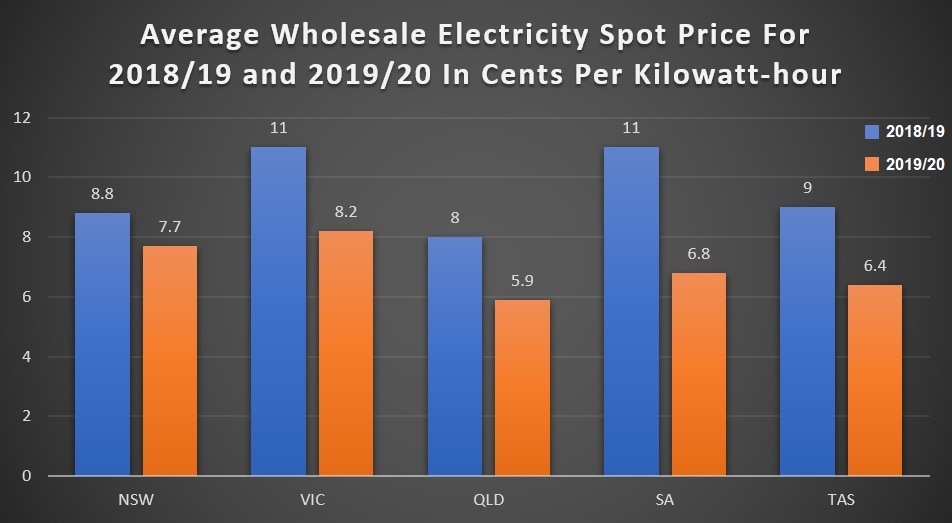
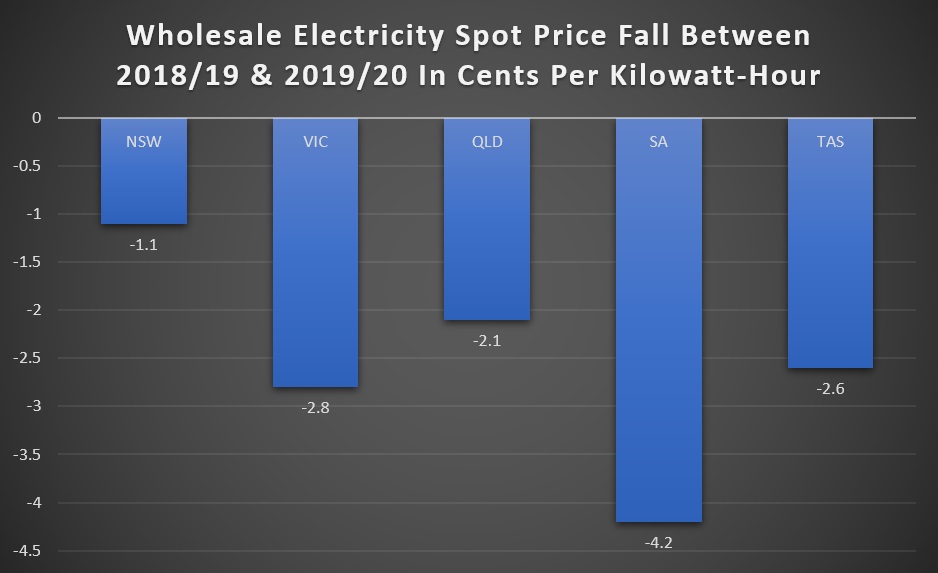
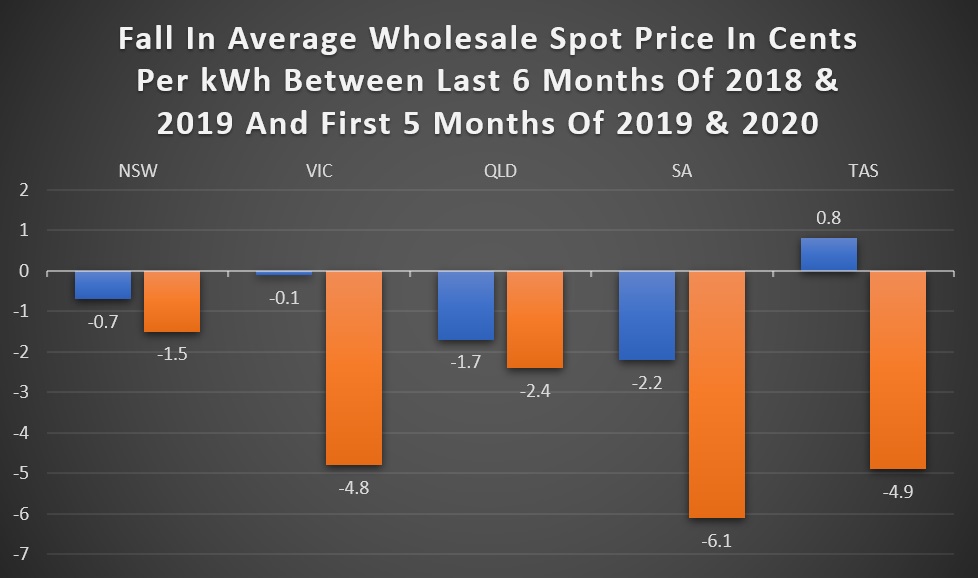
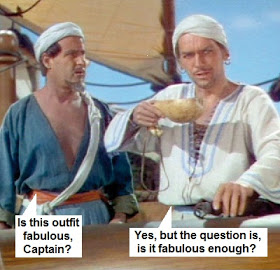
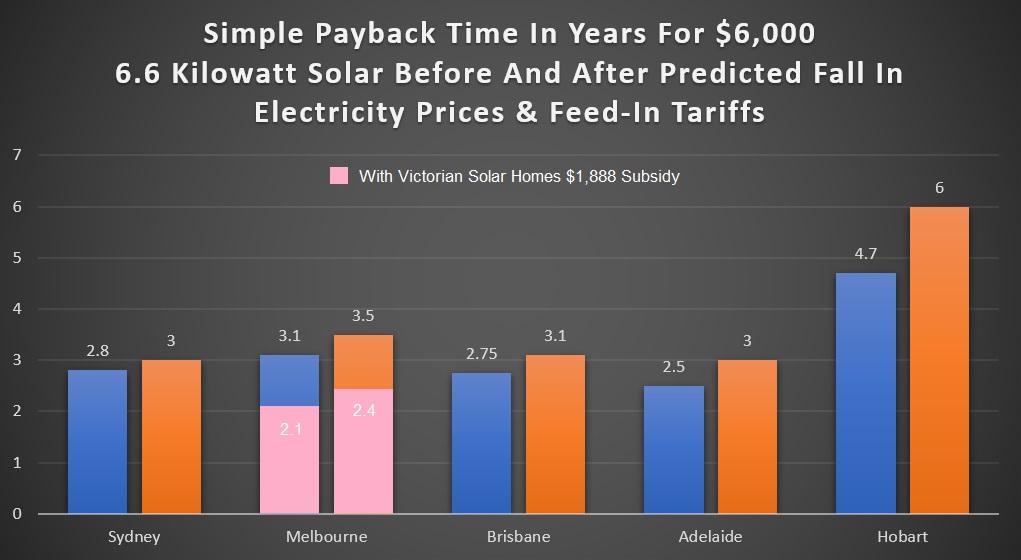
 RSS - Posts
RSS - Posts



Good article but I dont see Victoria changing their rates as we normally have ours adjusted at the start of each Calendar year not financial year.
Also does the Victorian pay back include the drop from 12c to 10.2 from 1st July?
Good point, Scott. I’ve added a note saying Victorians will have to wait to January for the fall to be passed on. The Victorian payback is calculated the same as for the other states with the fall in wholesale prices this financial year being subtracted from electricity prices and solar feed-in tariffs.
I was luckily enough to switch to Amber Electric on the 11th Feb, before this all happened and i have been enjoying low wholesale prices 🙂
my first month my average wholesale inc. GST was 4.87c per kWh
the following 2 months my average wholesale inc. GST was 2.97c per kWh
And there I was Ronald thinking you were having one of your comical digs at Dan Andrews recalcitrantly keeping Victorians in their houses to save them from the virus. I apologise !
Scott.. Here is the announcement of the 10.2c Fit for Victoria.
Tinyurl.com/yaexjpj9
Ron… Ironically this week my wonderful power rate of 21.21c/kWh was cancelled after 2 years. The best new rate I could get from AGL Victoria was 25.751c/kWh.. They lowered the Supply Charge from $1.20/day to $0.81/day. The overall affect was an increase in our monthly power bill of 15% after our Pensioner discount.. AGL are claiming our new rate is 12% under the Victorian default rate. It works in my favour because my 10 kW Solar/Battery system now enjoys the lower Supply Charge. I don’t want to change retailers because I’m well in credit caused by an accounting issue when we cut over to Solar last year.
Hi Colin
It might be worth asking AGL to pay you that credit rather than waiting to use it up – I’ve been in credit with AGL previously and they have paid the credit by cheque upon request by phone (noting it was for a positive elec bill due to solar rather than accounting error). They also transferred my elec credit to gas account (though no longer use them for gas).
cheers
Trev
Our “medical professionals” are not magicians. Barring the development of a safe and effective vaccine (highly unlikely) or symptomatic treatment (more likely), they have done absolutely nothing to reduce the potency of the virus in Australia. They have only delayed the impacts.
I’m not saying they should be able to reduce the potency, because that’s impossible.
But there is extremely thin logic in cheering the relatively low death count in Australia.
The virus spreads aggressively and mostly via asymptomatic transmission. In other words, suppress it all you like, but don’t think for a second you’ll be able to eliminate it.
Therefore, because the spread is inevitable and the potency remains the same, the eventual total death count has not changed – it’s just been delayed a little.
Well, that’s not exactly correct because slowing the spread can actually have the opposite of the intended effect – it can actually put more elderly/infirm persons at risk. Why? Because the optimal path is to establish resistance in the healthy and younger population in the fastest possible time. This results in a situation where the number of available hosts for the virus is reduced to the minimum in the shortest space of time. This consequently means that the vulnerable (elderly and multiply-comorbid) are exposed to risk of transmission for a shorter period of time and from fewer sources.
I’ll take Australia’s current position over that of the UK or Brazil any day of the week. And while it may take weeks, the coronavirus strain that causes COVID-19 will be eliminated from Australia.
I’ll take delayed death over immediate death thankyou very much.
From what point of view are you speaking?
…As a someone who is in the more “at risk” category (60+ and/or unhealthy)?
…or as one of the millions who are presently at risk of starvation because of the lockdown?
…or one of the thousand who, under the stress of the lockdown, have attempted to commit suicide?
…or as one of the women on the receiving end of lockdown-exacerbated domestic violence?
…or some other group?
There was a lockdown?
There were thousands committing sucide?
Good to know we have an expert epidemiologist sharing their obviously superior knowledge on a thread about energy prices… Oh, wait, we don’t. That’s OK then. Carry on….
Way to go, bloke. Classy.
No, I’m not an expert epidemiologist. If I was an expert epidemiologist, I would have done what most expert epidemiologists did – they made wildly pessimistic predictions about the death toll, freak everyone the hell out, and fail to make any clear statement about the uncertainty of those projections. There were some rare exceptions and those people have been mostly vilified and banned from social media despite the unfolding of time proving them to be correct. But if you still want to hang on every word of “experts” like Neil Ferguson of Imperial College, go for your life. It is (or was) a free country.
What I “am” is an Engineer is a specialist in modelling, statistics and measurement. I’ve been publicly calling bull$h*t on the dire predictions since around 25 March.
I’ve also been predicting massive unintended consequences of the lockdown/isolation. We’re already reaping the first waves of that now.
I fully realise this is a website about solar, but I’m trying to do my best, in the places where I can, to ask questions and raise awareness about issues around how the people of the world have responded to the coronavirus in the hopes that next time we don’t make the cure worse than the disease.
Let me get this right, John… You’ve come to an Australian site, a country where we’ve had around 100 COVID-19 deaths, to convince us our public health measures were a bad idea when if we’d failed to contain the virus as in the UK or Sweden we would have had around 10,000 or more deaths so far? I’m guessing you like to play computer games on the hardest difficulty level.
Replying to Ronald Brakels (no reply button past a certain comment depth):
I’ve come to an Australian site because I’m Australian, living in Australia, trying to cast light on what I think is a very disproportionate and myopic response to the appearance of a new strain of coronavirus.
I wish for a more holistic consideration of the total impacts of decisions made, with recognition of severe human impacts on those that aren’t (and will never be) COVID-19 victims in addition to those who, sadly, are.
You mention Sweden. They currently have 58 deaths per 100,000. That is where we’ll be in due course. It’s inevitable because absent total isolation of every man, woman, child and pet and sealing our borders for years this extremely contagious virus will eventually spread to every susceptible person. If not this exact version, then the next slightly different mutation (there are already multiple subtypes in existence because it mutates so fast). Such isolation is not feasible, and comes are unfathomable cost.
The UK was too late with the lockdown, so they are in the same boat as Sweden but the UK persists in inflicting tremendous societal pain with a lockdown that is too late to achieve anything.
But Sweden will not be inundated with anywhere near the number of unemployment claims. Or suicides. Or domestic violence. Or government debt. Or private debt. Or permanent mental health issues. I could go on.
There is something very bizarre to me about this fixation on COVID-19 deaths while all around us orders of magnitude more people are dying and suffering a wide range of serious negative long term consequences of our response to this coronavirus.
There is something very bizarre to me about our global seizure in the face of this coronavirus when multiple waves of more deadly infectious diseases, each of which has killed far more than COVID-19 ever will, have infected the globe over the past century and yet we didn’t lock down the world and shutter ourselves in our houses like we’re all doing now.
Why do you say everyone will get the current Coronavirus when only around one-third of the world’s population was infected with the 1919 influenza strain?
Ronald Brackels: Why do you say everyone will get the current Coronavirus when only around one-third of the world’s population was infected with the 1919 influenza strain?
Answer: Because I wasn’t being precise enough with my choice of words. My apologies. Restated with clarification: Everyone who is susceptible to infection will be infected at some point. Lockdown/isolation, if enacted early enough, will delay infections (but not avoid them).
Not everyone is susceptible to infection. In fact, as more data comes in it is becoming clear that perhaps even a majority of the population is already immune (that is, without requiring exposure, infection and recovery). A very large proportion of the very young are quite clearly not susceptible due to innate immunity – this is already broadly accepted in the scientific community. Also, it was clear to me from the numbers that a separate very large chunk of the older population has some kind of separate immunity. A recent paper in the journal Cell provides evidence that this is the case:
https://www.cell.com/cell/fulltext/S0092-8674(20)30610-3
They estimate between 40% and 60% of the populations has significant pre-existing cross-immunity due to exposure in the past to similar coronaviruses.
When we look at the death rates in the worst (ie. most advanced spread) regions like New York we find that the peak clearly has passed, and yet antibody studies show that “only” 15% – 25% of the population there has recovered. This only makes sense when you factor in the innately immune young and the cross-immune. Add those groups together and you have crossed the 60% estimated level of immunity required to break the back of exponential spread and thus expect to observe the declining fatality rates in those regions that we are currently witnessing.
This also has huge implications for the crude mortality rate. It means the crude mortality rate is much lower than the already hugely downward-revised projections of the “expert consensus”. The “expert consensus”, with each downward revision, is rapidly converging on the predictions of the minority of experts who were critical of the expert consensus.
So IF you are correct, New York State is almost safe from the virus after 30,000+ deaths. To get the the same point would take maybe 40,000 deaths in Australia. That’s how many Australians died in WW2.
I would advise caution using any stats from the CDC. It’s a whole discussion in itself but the US numbers are tainted in a number of ways, and the NY numbers are skewed even further due to the incredibly ill-advised practice of sending elderly COV)D-19 carriers back to their nursing homes.
But, that said, you could use New York numbers as a guide of what the Australian numbers would never be higher than. In which case, you are correct that the Australian COVID-19 death toll would be around 40,000. I take you at your word that is more than died in WW2 in nominal terms. But this is not directly comparable (see YLL below). Also, please note that even this max-extreme-worst-case number is (without intention to be crass) “only” 25% of the number of Australians that die each year from all causes – not 200% or 1000%.
But NY is an extreme outlier. A more trustworthy worst case estimate would be to use the higher death/100,000 stats from Europe. That’s around 65/100,000, which would put the projected Aussie death total at around 16,000, or about 10% of typical Australian all-cause mortality. Again, very regrettable but is it proportional to the measures taken?
But I believe it’s also very important to keep in mind that the majority of people counted as COVID-19 deaths are dying WITH coronavirus and not necessarily FROM it. This is very similar to what happens in years where more aggressive flu strains appear – it pushes the multiply-comorbid over the edge, causing a seasonal surge in deaths. In the overwhelming majority of cases, as confirmed by many senior experts, the deceased only had a-few-months-to-a-few-years more to live and COVID-19 brought the death on a somewhat earlier. Again, nonetheless regrettable.
Finally, there is also the well established concept of measuring impacts in terms of Years of Life Lost (YLL). Even by extreme-worst-case New York projection of 40,000 Aussie COVID-19 deaths, even if we assume all those died FROM (not WITH) coronavirus, the YLL total will only be a tiny fraction of the YLL for Aussie deaths in WW2, precisely because the median age of WW2 fatalities was much lower than C19 fatalities. Similarly, if a young person commits suicide due to the lockdown (as one Aussie did in the mandatory 14 day quarantine after returning to Australia from overseas), the YLL for that single death will be in the ballpark of the YLL for 10-70 average COVID-19 deaths due to the age difference.
Again, to be clear, death is always sad and regrettable, but when trying to minimise the total impact of the path taken it’s necessary to detach emotionally so that we don’t fall into the trap of devaluing or overlooking impacts that aren’t the current focus of attention of the majority.
John,
You state:
“But Sweden will not be inundated with anywhere near the number of unemployment claims. Or suicides. Or domestic violence. Or government debt. Or private debt. Or permanent mental health issues. I could go on.”
Where’s your evidence, John? I only see unsubstantiated statements. I’d suggest you view Charlie Pickering’s take on the COVID-19 crisis in the latest “The Weekly with Charlie Pickering – Series 6 Episode 5” from time interval 16:50 through to 21:58.
See: https://iview.abc.net.au/show/weekly-with-charlie-pickering
COVID-19 is already showing its deadly potential and it’s certainly not over yet. The Spanish Flu epidemic in 2018/19 had three waves, with the second wave being worse than the first one – don’t assume COVID-19 is finished just yet. Do you know what will happen in the future, John? I think not. I think you don’t have a clue, and yet you seem to me to suggest we proceed with a very dangerous experiment that could be existential for many lives.
Beware the Fine Print. I just had a 3.2 Kw solar system installed (by origin) and was advised I would receive a 21.5 cent FIT on the first 14 KWh per day. On further enquiring, post install, I was then made aware that FIT is only available to customers on a zero discount (full retail) rate. Select any other rate and you will only receive around 8 cents per KWh. I’m not particularly bothered other than about the misinformation as I am producing around 10 + KWh per day to offset our domestic consumption.
Hmmmm… . John’s with Don and Boris.
Like both, he’s certain he’s right.
I’d LOL, but it’s not funny… .
It certainly is a strange website to start trolling with made up ‘thousands of suicides’ ‘facts’. Like he’s going to convince anyone here that the Trump/Boris method was a good idea.
This article is likely inaccurate for Victoria for a number of reasons. For one, Victorians will likely pay more due to the state governments DMO plans being forced as old plans update. Also there is a fair bit of activity for poles and wires and most people get a consolidated view with no idea of the breakdown.
I actually doubt a lot will see decreases.
According to the AEMC:
https://www.aemc.gov.au/sites/default/files/2019-12/2019%20Residential%20Electricity%20Price%20Trends%20final%20report%20FINAL.pdf
Victoria’s long distance and local transmission costs should be holding fairly steady, but if you want to take that with a grain of salt I can certainly understand it.
It’s all good and well to say that wholesale prices are coming down.
The problem is the other parties’ charges that make up the electricity price will change this outcome very quickly. These can change independently of each other and as it happens, the NSW DSNPs are putting their prices up in their FY21 pricing prosposal which was approved by AER on 18th May. (well at least for Endeavour Energy, don’t know about Ausgrid and Essential).
The other components that make up the kWh charges are:-
TUOS – Transmission Use of System
DUOS – Distribution Use of System
NUOS – the two above combined
CCF – Climate Change Fund (could be called Carbon Cost)
EM – Environmental/Marketing Cost
LF – Loss Factor
AEMO – Wholesale Prices
Retail margin – what’s left after all the above has been paid out.
The distributors combine the DUOS and TUOS into NUOS (Network Use of System). Strange thing here (esp in NSW) is that DSNP charge a kWh usage rate and they don’t even generate the electricity, they just distribute it. This is even after the daily supply charge is factored in.
So, even if AEMO wholesale prices drop to 0. The distributors still get money both in terms of daily fees and usage fees!
Any drop in one way can be easily outweighed by increases in other ways.
The electricity market is a strange system in NEM.
The above also explains why we will never get 1:1 FiT. People often make the fundamental mistake that their FiT should match what they pay. It’ll never work because of the 5 or so individual components of the kWh being charged.
I am wondering about Amber. My son told me about it but also said that they can go sky high when electricity use is high because of weather etc. I am not prepared to turn my air-con off to save electricity. Living at Ipswich where the summers are hot and the winters cold I need my comfort. Does anyone have news on this?
Yes it can sky rocket in summer especially but you are protected by the fact you will not pay more the Default Market Offer.
I’ll let you know how it goes over summer but I suspect when the prices are high my solar will cover me and maybe export a bit of solar at high prices too
Interesting – I’ve just signed up for AGL Solar Savers – they told me because it’s a 12-month ‘plan’ they can change the rates but the FIT is ‘guaranteed’. Any idea if this is ‘guarantee’ is correct?
Vicki read the contract they send you, im sure they will have a clause that says “the 21.5c is made of 12c plus bonus 9.5c and st any time they can cancel the bonus”
Ronald, There are a few of us domestic PV generators in the ACT that continue with a FIXED fit still higher than our user tariff(s).
Today I received an offer from EnergyAustralia (my current provider).
I’m currently on a 14% discount off these rates:
Daily supply charge: $0.9020 per day
Peak Usage: 29.6879 cents/kWh
Off Peak: 12.4278 cents/kWh
I’ve been offered a 17% discount on the same rates for 2 years. After July 2020, do you see a drop in NSW prices larger than the 3 percentage points in discount I’ve been offered?
Thanks.
My admittedly rough prediction for NSW is for a 7% fall in electricity prices there. This should be enough to bring your discount up to 21% or maybe 20% after inflation is taken into account. So while having your discount increased to 17% isn’t bad, it’s possible you will be able to find something better if you wait a month or two.
Good article except for the ignorant comment about starting a trade war with China being stupid.
China has been in a trade war with the western world for decades now. China has used government-sponsored dumping of products far below cost price to control trade. China also heavily taxies imports.
China started a trade war a long time ago, and recent events are just a reaction to the loss of manufacturing jobs from globalisation utilising underpaid labour to produce goods.
Fighting back against this is only stupid if you are happy with people underpaid people producing goods, environmental waste of shipping them across the world, and China taxing goods coming in but complaining to WTO when their products are taxed.
The author watches too much CNN and should not comment on topics he does not understand
I’d suggest retaliating tit for tat and selling China iron ore, wheat, beef, and natural gas at below what it costs us to produce them — but I fail to see how that would benefit us.